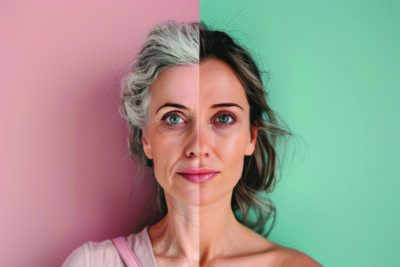Think about a world where a light is restoring your skin’s lost color.
Red light therapy lamp is becoming popular for skin pigmentation treatment among people with vitiligo.
- The common skin condition, vitiligo, affects around 0.5 to 1% of the global population. [Source: thedermgrouppartners]
- Research shows that red light therapy stimulates melanocyte production, healing repigmentation of the vitiligo patients. [Source: Rogue | Harnessing the Power of Red Light Therapy for Vitiligo]
How Does Light Therapy Work For Vitiligo?
- The light enters the skin and improves mitochondria function.
- Mitochondria produce more ATP, giving cells more energy to repair and grow.
- This helps the skin regain its natural color.
- The light also lowers inflammation and soothes the immune system.
Understanding Important Facts About Vitiligo
Loss of pigments leads to white patches on the skin. This is a chronic skin condition called Vitiligo.
Vitiligo happens when the cells that make melanin (called melanocytes) are destroyed.
Doctors believe that an autoimmune disorder mistakenly attacks melanocytes, leading to vitiligo. However, the exact cause of vitiligo is still unclear. Genetic factors and the environment may also trigger vitiligo.
The condition affects around 0.76% to 1.11% of the population of the USA. However, 40% of the cases are left undiagnosed there. It commonly appears before the age of 30, but it can still develop at any age.
Traditional treatment for the condition is very slow. It requires a long-term commitment. Topical corticosteroids and calcineurin inhibitors weaken the immune response. However, they also thin the skin and irritate it.
Narrowband UVB phototherapy takes time and regular sessions to activate melanocytes. It can also cause side effects like skin redness, mild burns, and dryness.
Doctors use treatments like skin grafting and depigmentation therapy for severe cases. However, no traditional cure for vitiligo is guaranteed.
What is Red Light Therapy?
RLT is a widely popular, non-invasive treatment. It utilizes low-level red and the near-infrared light to work on the skin by penetration.
RLT aids wound, inflammation, and collagen production in dermatology. However, it does not give birth to skin damage or cancer, like UV-based therapies.
Without risks of UV exposure, RLT heals melanocyte regeneration. It works on reducing inflammation and also improves repigmentation.
Red Light Therapy vs. UVB Therapy
Let us find out the differences between red light therapy vs UVB therapy in a quick.
| Features | Red Light Therapy | UVB Therapy |
| Mechanism | Stimulates the mitochondria for cellular repair and the regeneration | Activates the melanocytes and suppresses the attack of the immune |
| Penetration Depth | Deep penetration, for example, up to 10mm | Limited penetration only up to the epidermal level |
| Treatment Duration | 10 to 20 minutes per session | 2 to 3 sessions per week for months |
| Risk of Skin Damage | No major risk of skin damage found | Burns, skin aging, and cancer risk |
| Effectiveness in Vitiligo | Supports melanocyte health and repigmentation | Induce repigmentation sometimes |
| Accessibility | Can be used at both home and hospital | Requires a doctor’s supervision |
Red Light Therapy and Vitiligo: The Connection
RLT is now the best solution for the treatment of vitiligo.
Studies show that red light revives melanocyte production, healing repigmentation in vitiligo patients.
A 633nm red light enhances mitochondrial function in melanocytes. This process regenerates and repigments the skin.
Red Light Therapy For Vitiligo: Practical Considerations
At-Home Red Light Therapy
If you are planning for the at-home device, then check if it is FDA-approved. Also, check if it is made for home use or not for safety. Check the appropriate wavelength ranges the device offers.
Consulting Healthcare Providers
Please consult with a doctor before using a red-light therapy device at home. Only the doctor can suggest the best approach according to your needs.
Potential Side Effects
Every treatment has its side effects, and so does red light therapy. It comes with potential side effects, which are curable with little precautions.
| Potential Side Effects | Precautions |
| Skin redness temporarily | Do not overuse the device; maintain the recommended time and distance |
| Irritation of the skin | Test on a small area of skin to check the sensitivity |
| Discomfort or eye strain | Do not forget to wear eye protection to save your eyes from intense exposure to light |
| Headache | Take breaks between the treatments. Reduce time or intensity of the sessions |
| Light sensitivity | Please consult a doctor and check out if you are sensitive to light. |
| Increasing existing skin problems | Consult a dermatologist before taking red light therapy if you have active skin conditions |
| Pain from overusing | Limited timeframe and sessions |
| Dryness of the skin | Use moisturizer if you face dryness issues |
| Mild burning sensation | Discontinue taking the therapy and consult a doctor |
Red Light Therapy For Vitiligo: Frequently Asked Questions
What light therapy is best for vitiligo?
Different treatments work for different people. Some people find red light therapy effective with little to no side effects. Others get better results with narrowband ultraviolet B (NB-UVB) therapy. Researchers need to study red light therapy more for vitiligo repigmentation, while NB-UVB has already been proven effective.
Does red light help with pigmentation?
RLT helps with pigmentation by stimulating mitochondria and supporting cell growth. It creates an anti-inflammatory environment, which helps melanocytes survive and function better.
What is the success rate of light therapy for vitiligo?
Light therapy helps about 50% to 75% of vitiligo patients. It works best on the face and neck. However, the results depend on the type of vitiligo, how long the patient has had it, and which area is affected
What light is used to treat vitiligo?
Narrow-band ultraviolet B (NB-UVB) light therapy at 311 nm is a common treatment for vitiligo. Doctors prefer it over PUVA because it is safer and more effective. Red light therapy also helps by reducing inflammation and controlling melanocyte activity.






